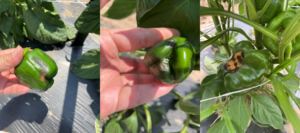We observed a large amount of unmarketable pepper fruit hanging on the plants during on-farm visits and at the research farms recently. Damage appears on the sides or at the bottom of the fruit (Figure 1). The symptoms that occur at the fruit bottom are similar to tomato blossom end rot (BER), a plant physiological disorder known to be associated with inadequate translocation of calcium to developing fruit. This phenomenon is often caused by an uneven supply of water.
However, we noticed the occurrence of unmarketable pepper fruit is not as closely associated with water supply as BER in tomatoes is. In our irrigation demonstration plot, there was a significant amount of unmarketable pepper fruit on plants that received the same amount of irrigation as tomato plants that had minimal BER. Other factors might cause the fruit to be unmarketable. Here, we discuss how temperature and light cause pepper sunburn (sunscald), another important plant physiological disorder that results in unmarketable pepper fruit.
The fruit sunscalds are caused by two factors. One is the high temperature at the fruit surface that exceeds the threshold for damage. Some literature suggests the threshold temperatures for peppers are about 100-105 °F. It is likely the temperature threshold at the fruit surface was reached in the very hot days in June. Excessive light is another factor causing the damage. When plants receive excessive light, a chlorophyll molecule transfers the excess light energy and produces toxic molecules (singlet oxygen, superoxide and peroxide) that cause cell death.
The combined effects of high temperature and excessive light cause pepper sunscald that at least partially contributes to the unmarketable fruit we have observed. Sunscald symptom is first shown as a loss of pigmentation. It results in browning or bleaching on the exposed side, the discoloration becomes necrotic as the symptom progresses. As initial symptoms of both pepper sunscald and BER involve discoloration, and damage caused by BER can extend to the sides of the pepper fruit, I found it is not always easy to separate damage caused by the two physiological disorders.
However, one difference between the two physiological disorders is that BER may develop throughout the entire process of fruit development, while susceptibility to sunscald differs at the different fruit development stages. The mature-green pepper is more susceptible to sunscald than immature green peppers, and red peppers are the least susceptible to sunscald.
Regardless, both BER and sunscald cause pepper fruit to be unmarketable. In dry and hot conditions, evenly supplying water, and applying moderate shading is helpful in increasing bell pepper fruit marketability.
